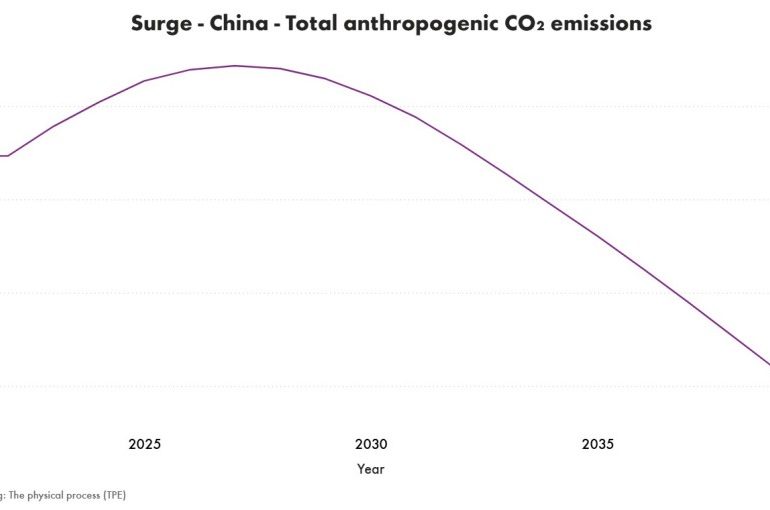Last week, in the midst of the UN General Assembly and the associated Climate Week in New York, Chinese President Xi Jinping announced a new greenhouse gas target for the country for the period out to 2035 as required under the Paris Agreement. This will form part of the formal UNFCCC submission of the Chinese nationally determined contribution, due this year and required to extend to 2035 as per the Paris Agreement rule-book. President Xi said that by 2035 China’s greenhouse gas emissions would be 7 to 10% lower than the peak, which although unspecified and yet to happen, is imminent. The peak relates to China’s first nationally determined contribution (NDC), submitted in February 2016, when the country pledged to peak CO2 emissions by around 2030, reduce CO2 intensity by 60-65% from 2005 levels by the same year, and increase the share of non-fossil fuels in its primary energy mix to around 20% by 2030.
The new goal is the first absolute reduction target announced by China and sets the scene for the subsequent 30 years journey to net-zero emissions. China set its net-zero target in 2020 through a previous announcement by President Xi Jinping. That announcement reiterated the aim to have CO2 emissions peak before 2030 and then went on to commit to achieve carbon neutrality before 2060; to lower CO2 emissions per unit of GDP by over 65% from the 2005 level, to increase the share of non-fossil fuels in primary energy consumption to around 25%, to increase the forest stock volume by 6 billion cubic meters from the 2005 level, and to bring its total installed capacity of wind and solar power to over 1.2 billion kilowatts by 2030.
According to the English version of the Chinese State Council website, President Xi Jinping announced China will, by 2035, reduce economy-wide net greenhouse gas emissions by 7 percent to 10 percent from peak levels, striving to do better; increase the share of non-fossil fuels in total energy consumption to over 30 percent; expand the installed capacity of wind and solar power to over six times the 2020 levels, striving to bring the total to 3,600 gigawatts; scale up the total forest stock volume to over 24 billion cubic meters; make new energy vehicles the mainstream in the sales of new vehicles; expand the National Carbon Emissions Trading Market to cover major high-emission sectors; and basically establish a climate resilient society.
So how important is this and how does it compare to a possible scenario for China?
In Shell, as part of our development of global energy scenarios, our energy team models the world energy system under different scenarios through to 2100. We use International Energy Agency (IEA) data for the period up to the present, then our own modelling capability for the future. Much of the data is published and it can be used to look into the energy system supporting specific sectors within individual countries. The current 2025 Energy Security Scenarios provide an up-to-date analytical toolkit for assessing the Chinese target.
The first step is to look at the goal itself; notably it is a reduction of 7 to 10% in greenhouse gas emissions, not just CO2. This probably makes the target more difficult than at first look, in that methane, nitrous oxide and other greenhouse gases are notoriously difficult to manage. These are often fugitive emissions from multiple sources, and a good proportion are related to agriculture, such as rearing cattle and growing rice in the case of methane.
We estimate that China’s total anthropogenic CO2 emissions in 2024 were 13.0 Gt, of which 12 Gt comes from their energy system. In 2018 China reported that the other greenhouse gases amounted to a further 2.22 Gt CO2 equivalent, which appears to be the best currently available figure. That puts total greenhouse gas emissions in 2024 at about 15.2 Gt CO2 equivalent. But this is not the peak, which is the baseline for their 2035 goal. In our Surge scenario, which represents a world of rapid change as new technologies emerge in the energy system and artificial intelligence becomes ubiquitous globally, peak Chinese CO2 emissions are in 2027 at 13.4 Gt CO2, so 15.6 Gt CO2 equivalent for total greenhouse gases, if we assume the total non-CO2 emissions remain at 2.2 Gt.
A 10% reduction in emissions by 2035 from the peak therefore means emissions of 14.0 Gt CO2 equivalent in that year. If we assume that the 10% reduction target applies equally to CO2 and the other greenhouse gases, that means a CO2 target of some 12 Gt CO2 in 2035 for China.
The Surge scenario CO2 profile is shown above and by 2035 emissions in China are consistently tracking downwards and have reached 11.6 Gt. This is slightly below the stated Chinese goal, implying that they could do even better, which is also what President Xi said in his announcement.
Surge is a scenario which is illustrative of many of the trends that can be seen in China today. It highlights the rapid shift towards road transport electrification, both for cars and trucks, the immense capacity available in China for manufacturing solar PV panels and batteries, the development of new nuclear power technologies, the production of synthetic fuels for sectors such as aviation, and perhaps most importantly, a real effort to manage CO2 emissions. In that framing, increased natural gas use in the Surge scenario helps China reduce coal demand in the short term. Overall, it’s an exciting story-line and reflects the technological dynamism in the Chinese economy today.
But Surge isn’t a scenario with an outcome that limits warming to 1.5°C, for that the CO2 goal for China in 2035 would need to be 8 Gt, or a reduction of some 30% in just 8 years, as illustrated in our Horizon scenario. Nevertheless, Surge sees the world reach net-zero CO2emissions by 2080 and limit warming to 2°C in 2100, with China playing a key role in delivering that outcome. Not only does Surge see China consistently reduce emissions over the coming decades, but China, which we call the Great Wall of Change in our scenario archetype categorization, is the major producer of the energy infrastructure the world needs to reach net-zero emissions.
The announcement by President Xi may not have been everything that everyone was hoping for, but it is a critical and important step to push the world towards the requirement of Article 4 of the Paris Agreement, ‘a balance between anthropogenic emissions by sources and removals by sinks of greenhouse gases in the second half of this century‘.
Note: Shell Scenarios are not predictions or expectations of what will happen, or what will probably happen. They are not expressions of Shell’s strategy, and they are not Shell’s business plan; they are one of the many inputs used by Shell to stretch thinking whilst making decisions. Read more in the Definitions and Cautionary note. Scenarios are informed by data, constructed using models and contain insights from leading experts in the relevant fields. Ultimately, for all readers, scenarios are intended as an aid to making better decisions. They stretch minds, broaden horizons and explore assumptions.
Leave a comment



